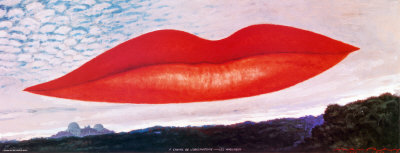Cloud Convergences
A month ago I was handed a photocopy of page from this book (above). I had never heard of the book but immediately tracked down a copy at my local public library because the pages I was given were about clouds (below). This type of cloud is quite common around here and are most often seen hovering above Mount Rainier. They are called
altocumulus lenticularis--the flying saucer cloud, the "lennie."
This type of cloud is not, however, common in Los Angeles where one particularly shapely "lennie" appeared one November day in 1976. According the Lawrence Weschler, "Anybody who was in town that day and happened to look up remembers that cloud," one he describes as a "great-dreamy-somnambulant blimp of a cloud...floating, pink, langorous, bulbous and surreal..."
Weschler, a long-time staff writer for
The New Yorker and prize-winner author of many works of non-fiction and creative non-fiction, was obviously quite taken with this cloud. But not because it was a rare meteorological event, but because it bore an uncanny resemblance to a 1933 painting by Marc Chagall (below) that Weschler had seen in a catalogue of the artist's work.
This is "Nu au-dessus de Vitebsk" which may or may not remind you of a lennie. Certainly the nude is reposing on a cloud-like sheet, she is floating in a cloud-like manner, and her curvilinear "bulbous" shape is more like an altocumulus than a cirrostratus or, heaven forbid, a cumulus congestus. Weschler doesn't think Chagall's composition is happenstance, but that this artist is expressing some universal form that arises from the common human experience of nature or art. Chagall may have thought he was being original, but Weschler purports that he was likely influenced--perhaps subliminally--by another artist, Man Ray.
This is A l'Heure de l'Observation: les Amoureux. Because of their size, the lips are meant to represent not a mouth, but two joined bodies floating above the earth against a sky dotted with altocumulus perlucidis clouds.
Weschler considers these images--rising subliminally or intentionally from our conscience--convergences. Some of the images grouped together in his book undoubtedly share common sources of influence, but I am not convinced that the convergences are not simply the result the Weschler's clever ability to recognize "similar" images from what must be the enormous stock of images he holds in his memory or encounters in his daily life. In a slightly oddball lecture posted on
YouTube, Weschler matches images of a partically prostrate body of woman just recovering from swimming the English Channel, St. Theresa in Ecstacy, and Christ being taken down from the cross. It's hard to believe there is any mimickry going on here (life imitating art, or art imitating art), but you've got to wonder--do human bodies in extreme states take on a particular posture or form? Or are we just looking for similarities, the way the defunct
Spy magazine did so brilliantly in their "Separated at Birth?" feature back in the Eighties.
I do not need to be convinced that Weschler's convergences are meaningful to be amused and fascinated by his book and the way his mind works. This book is good for the synapses and great for people interested in learning new ways of looking at the world around them.



